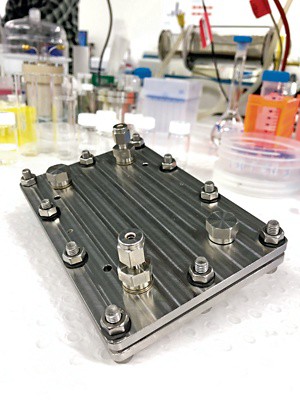NEWS BRIEF: The industrial process for ammonia production is increasingly being recognized as a target for decarbonization - by researchers, investors, regulators, and the producers themselves. Demonstrating this shift in awareness, Chemical and Engineering News (C&EN), one of the flagship publications of the American Chemical Society (ACS), this week published an in-depth review of global research and development efforts and demonstration plants for sustainable ammonia synthesis. Its review is all-encompassing, from near-term feasible renewable Haber-Bosch plants, to long-term research areas of electrochemistry, photocatalysis, and bioengineering.
Content Related to University of Arkansas
Presentation
DFT Analysis of Elementary N2 Electro-Reduction Kinetics on Transition Metal Surfaces
Ammonia is currently produced through the catalytic Haber Bosch process (HB) at temperatures of about 300 to 500 °C and pressure of about 200-300 atm. In a future with plentiful renewable electricity from distributed sources, an electro-chemical system to produce ammonia could efficiently generate ammonia on site and on demand. Possible heterogeneous catalysts for electro-chemical nitrogen reduction are currently marred by the poor rate and selectivity due to difficulty in activating the strong N-N bond and to the competing hydrogen evolution reaction (HER), resulting in infeasible faradaic efficiency. To develop more selective and active catalysts, better understanding of the mechanistic…
Presentation
Enhanced Electrochemical Ammonia Production Via Peptide-Bound Metal
Approximately half of the people on the planet are alive because of synthetically produced ammonia. However, due to the fossil fuels used in the current ammonia synthesis process, its production contributes a significant amount to the world’s greenhouse gas emissions. Haber-Bosch synthesis, which is the most widely used method of producing synthetic ammonia today, requires high temperatures (400-500 °C) and pressures (150-200 atm). This process is also energy intensive, consuming approximately 2% of worldwide energy. By taking an electrochemically-based approach to ammonia synthesis, those harsh conditions and emissions can be eliminated. However, current catalysts are not selective for the desired…
Article
Future Ammonia Technologies: Electrochemical (part 2)
Trevor Brown December 27, 2017
Last week, in Part 1 of this series on electrochemical ammonia synthesis technologies, I quoted a recent article by researchers at MIT that identified avenues for future research and development. One option was a biomimicry approach, learning from "enzymatic catalysts, such as nitrogenases," which can "either be incorporated into or provide inspiration for the design of electrocatalytic processes." The nitrogenase enzyme, nature's ammonia synthesis technology, was developed in an iterative innovation process, otherwise known as evolution, that took hundreds of millions of years to reach this level of efficiency. According to one group of electrochemists, who presented their results at the recent NH3 Energy+ conference, nitrogenase produces ammonia in nature with an enviable 75% process efficiency - so it's no surprise that they are basing their industrial technology on it.
Presentation
Exploring Peptide-Bound Catalysts for Electrochemical Ammonia Generation
Charles LoneyAshley GraybillCheyan XuJulie RennerPrashant AcharyaDavid SuttmillerLauren F. GreenleeLuke WilesKatherine AyersWayne Gellett
Today, most ammonia (NH3) manufacturing occurs via the Haber-Bosch process. This process consumes hydrogen from fossil fuels, and as a result NH3 contributes the highest amount of greenhouse gas emissions out of the top 18 large-volume chemicals made globally. Because the process is high temperature (400°–500°C) and pressure (150–300 atm) with a low (15%) single-pass conversion efficiency, the plants have to be very large to be economical. This means that ammonia is shipped from centralized locations, further increasing greenhouse gas emissions because of the fuel consumed in transportation. Additionally, their large size makes it difficult to integrate with renewable sources…
Presentation
Design of Iron-Nickel Nanocatalysts for Low-Temperature Electrochemical Ammonia Generation
Lauren F. GreenleeShelby FosterPrashant AcharyaDavid SuttmillerCharles LoneyJulie RennerWayne GellettKatherine Ayers
The Haber-Bosch industrial process for ammonia production is the cornerstone of modern commercial-fertilizer-based agriculture. Haber-Bosch ammonia fueled the global population growth of the 20th century, and approximately half of the nitrogen in human bodies today originates from ammonia-based fertilizer produced by the Haber-Bosch process. However, the Haber-Bosch process operates at high temperature and high pressure to achieve high conversion efficiencies, and the hydrogen input comes from steam reforming of coal or natural gas. In addition to the energy costs, the large production of carbon dioxide as a greenhouse gas and the large required economies of scale motivate research efforts to…
Article
US DOE funding research into sustainable ammonia synthesis
Trevor Brown January 27, 2017
The US Department of Energy (DOE) is currently supporting six fundamental research projects that will develop "novel catalysts and mechanisms for nitrogen activation," which it hopes will lead to future sustainable ammonia synthesis technologies. These projects, announced in August 2016 and administered by the Office of Basic Energy Sciences, aim "to investigate some of the outstanding scientific questions in the synthesis of ammonia (NH3) from nitrogen (N2) using processes that do not generate greenhouse gases."
Presentation
High Efficiency Low Cost Electrochemical Ammonia Production
High Efficiency Low Cost Electrochemical Ammonia Production Stephen Szymanski, Julie Renner*, Proton OnSite, Lauren Greenlee, University of Arkansas







